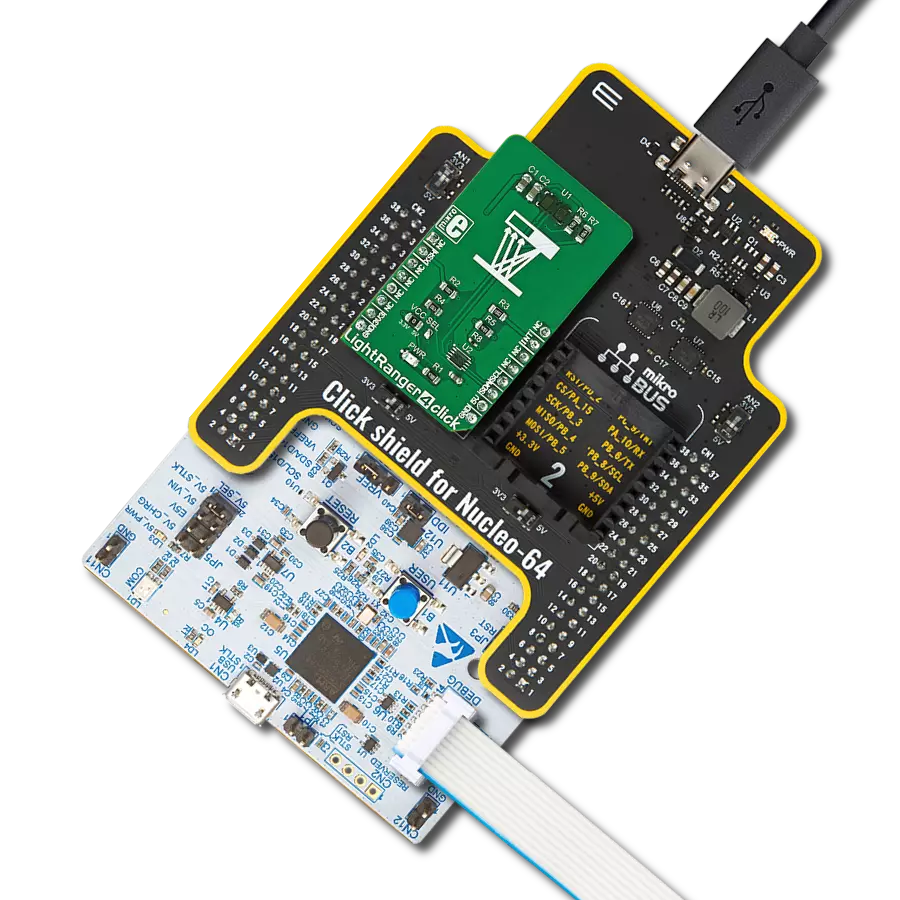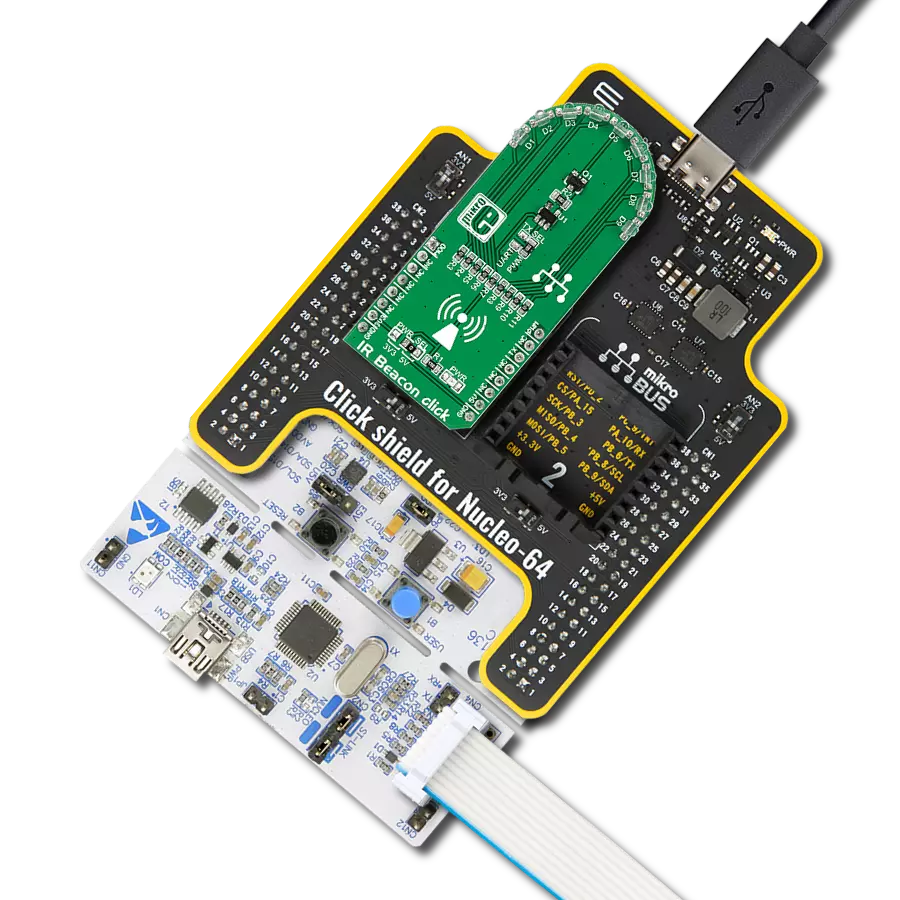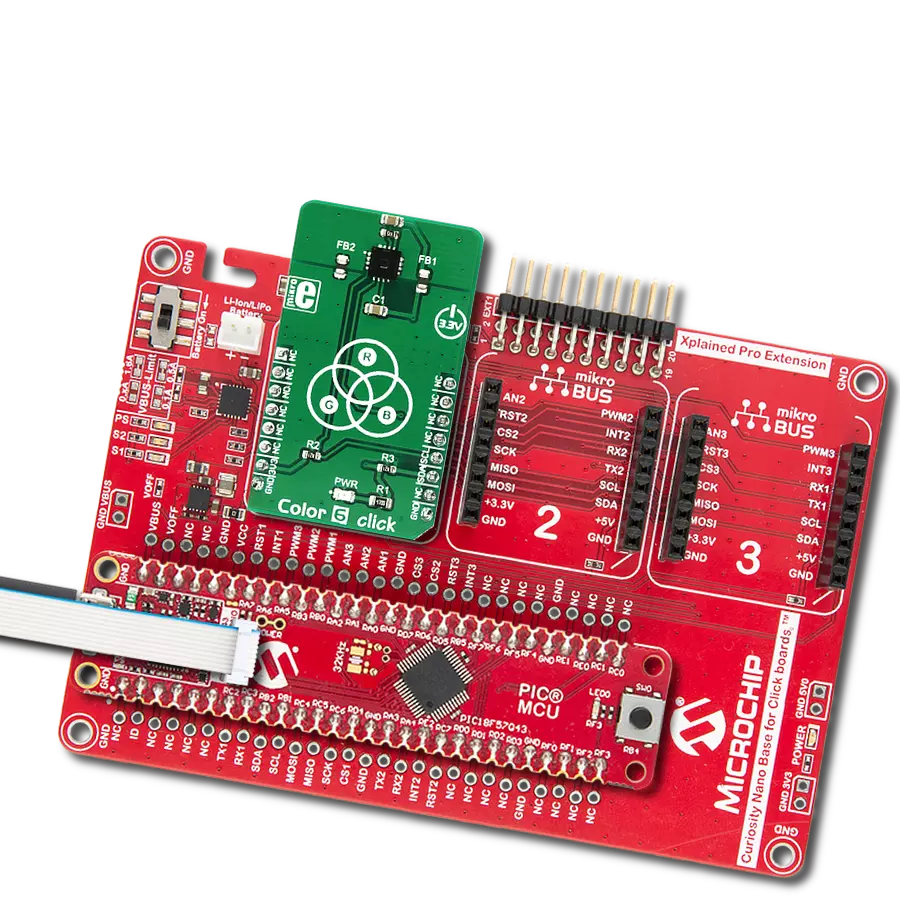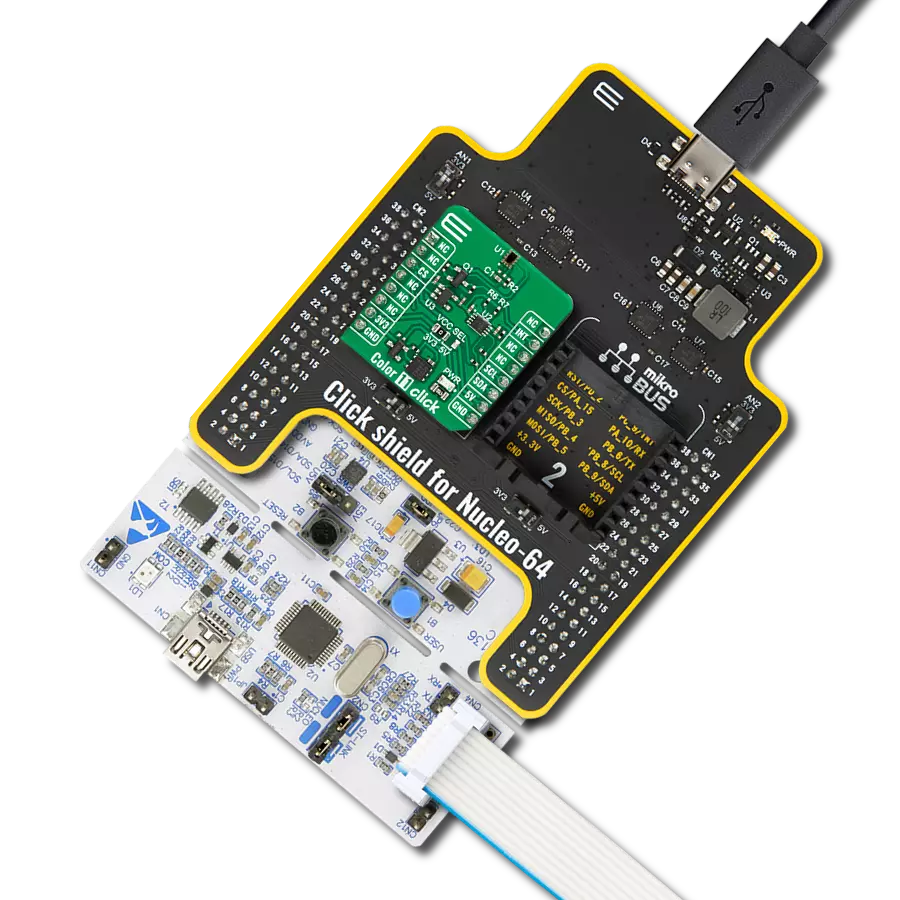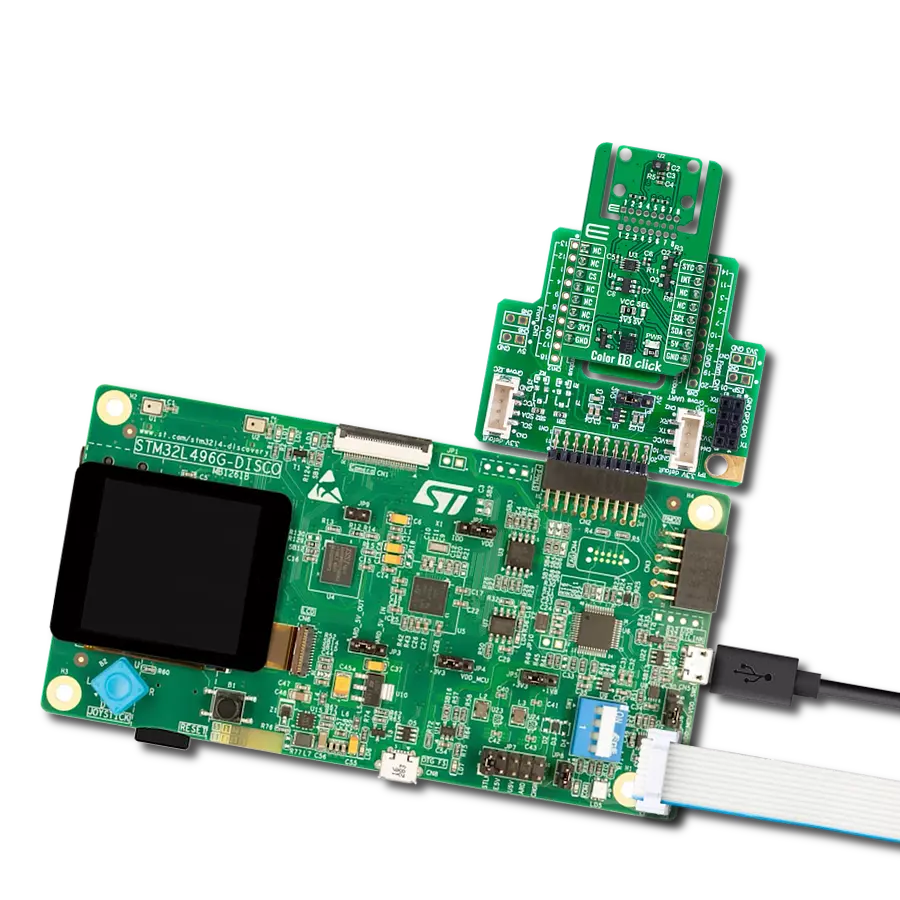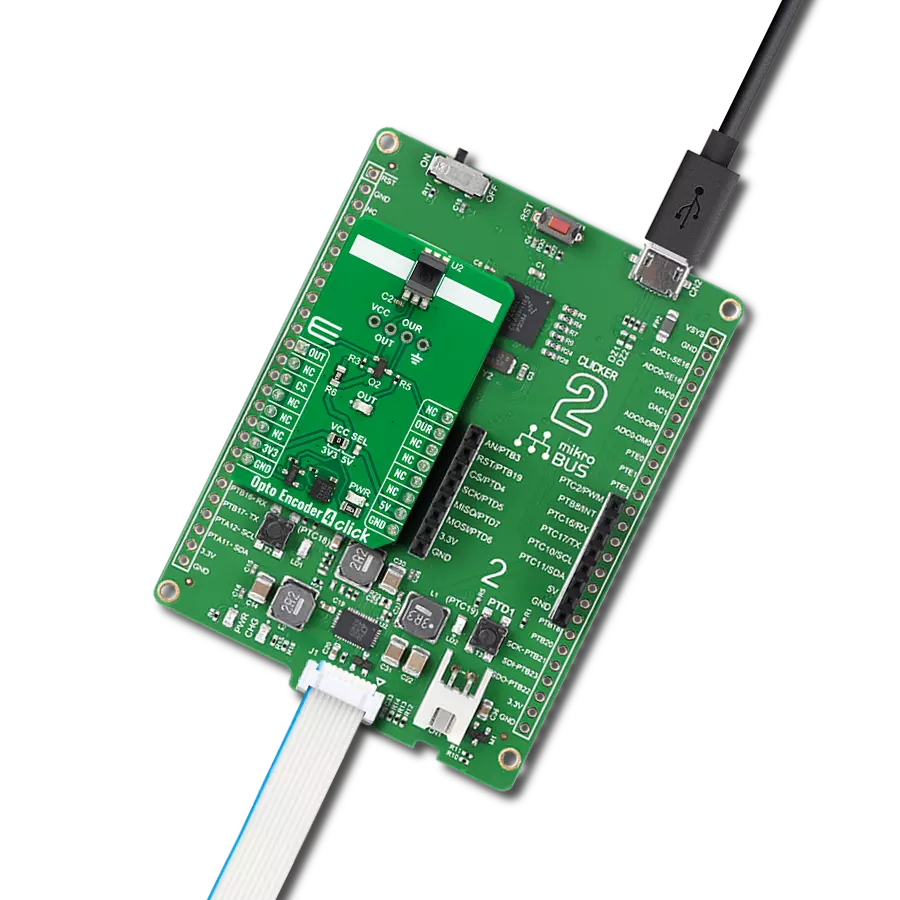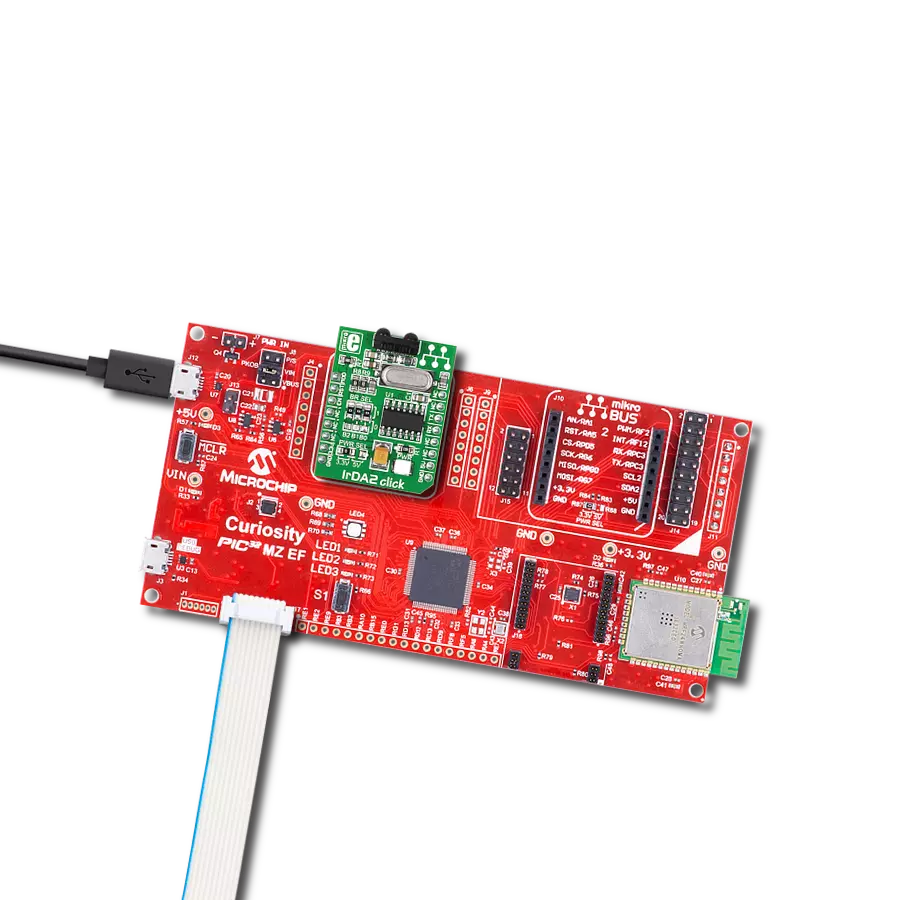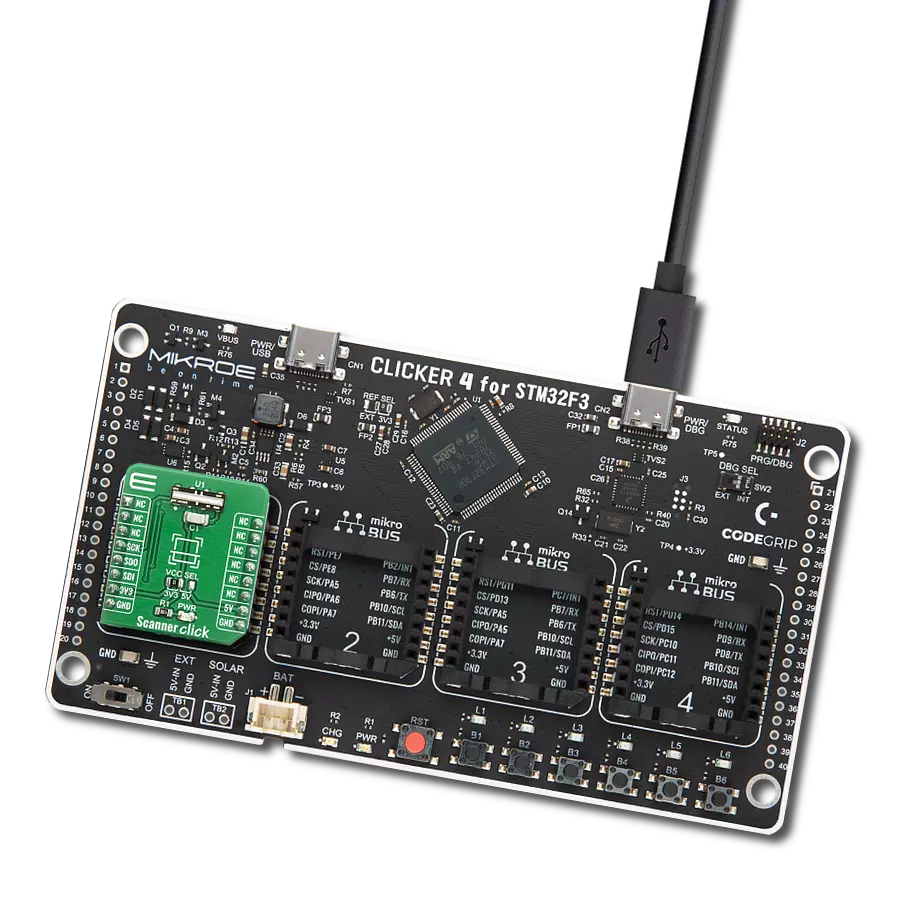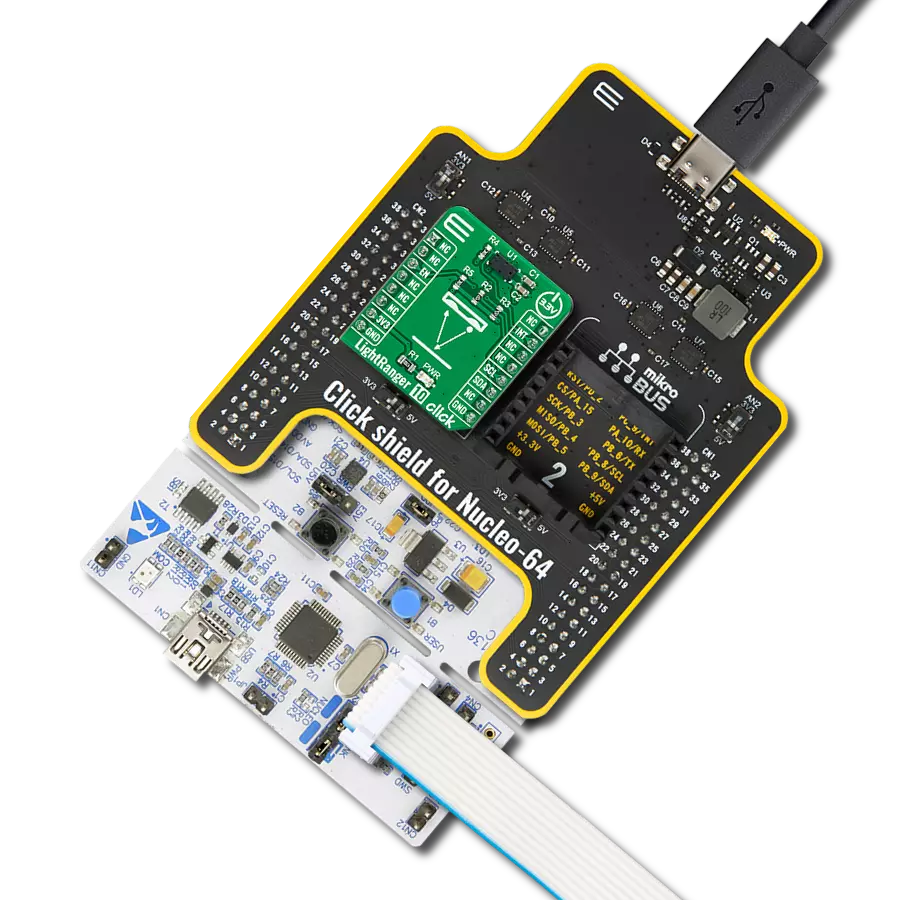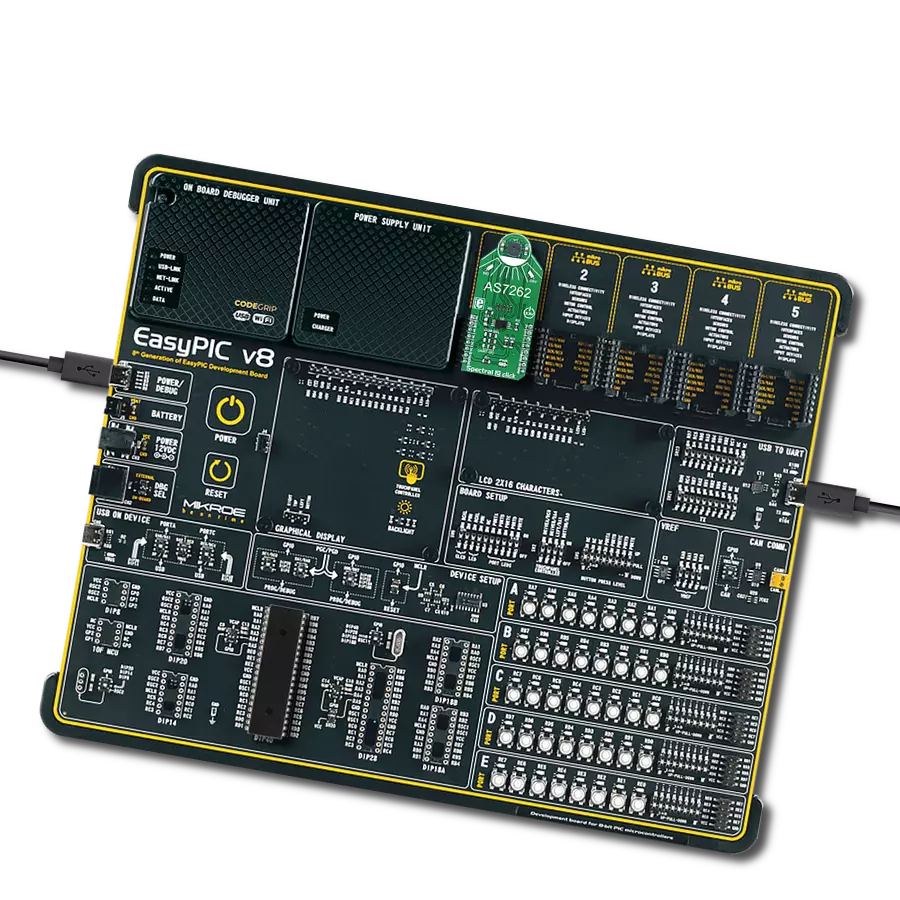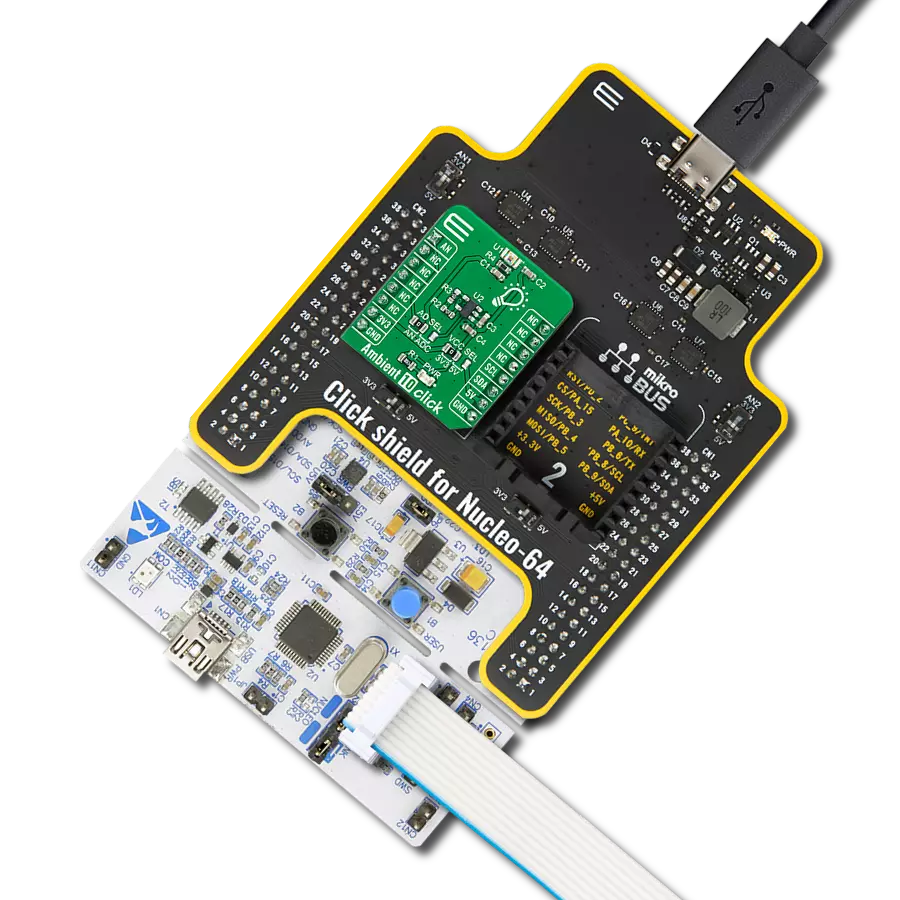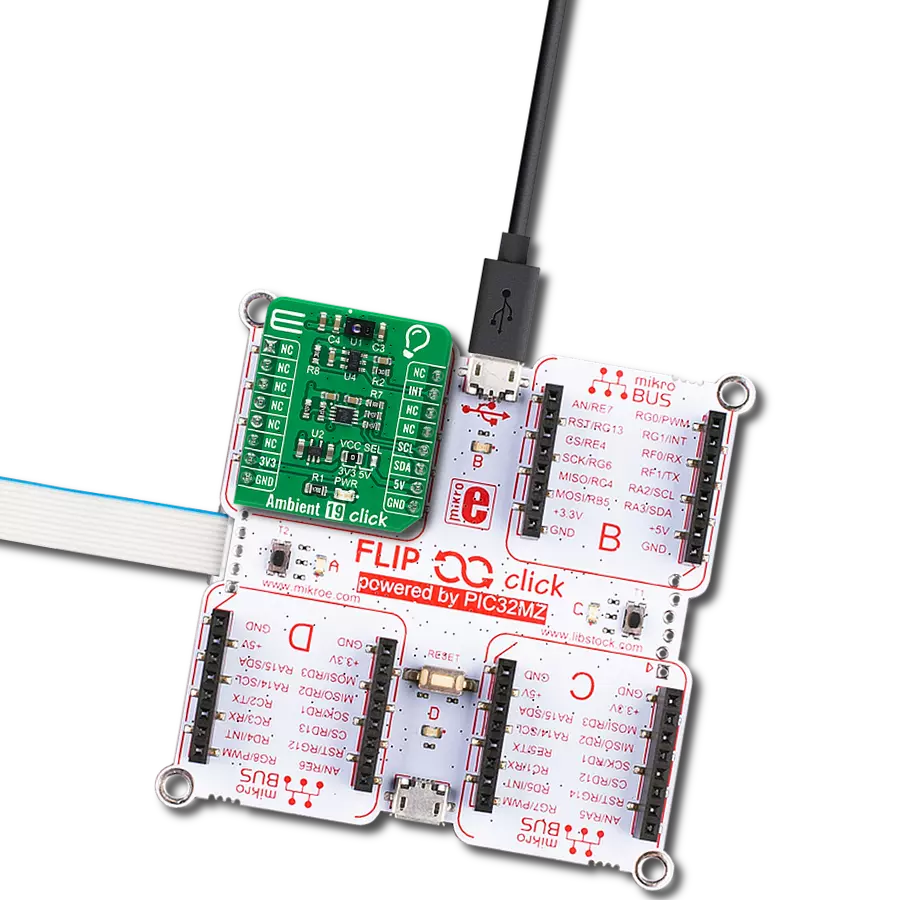Detect and analyze light with 14-channel spectral sensor ideal for color matching, material analysis, and light characterization
A
A
Hardware Overview
How does it work?
Color 16 Click is based on the AS7343, a 14-channel multi-purpose spectral sensor from ams OSRAM, providing fast and accurate spectral measurements. It is optimized for reflective (thanks to an onboard LDC red LED controlled through LDR pin), transmissive, and emissive light applications, including color matching, fluid or reagent analysis, lateral flow test applications, and spectral identification in the visible range. The AS7343 has a built-in aperture that controls the light entering the sensor array to increase accuracy. The spectral response is defined by individual channels covering approximately 380nm to 1000nm with 11 channels centered in the visible spectrum, one near-infrared, and a clear channel. The AS7343 features a 5x5 photodiode array. Above and below the array there are two photodiodes with dedicated functions such as flicker detection and near-infrared response,
while in each corner, the array has a photodiode without filter that is responsive in the visible spectral range. The AS7343 can detect 14 channels - 12 wavelengths, plus a clear and flicker output channel - making this Click board™ great for LED color calibration, miniature optical spectrometers, and more. This sensor does not need a specific Power-Up sequence but requires a voltage of 1.8V for its interface and logic part to work correctly. Therefore, a small regulating LDO, the TLV700, provides a 1.8V out of selected mikroBUS™ power rail. Color 16 Click communicates with MCU using the standard I2C 2-Wire interface with a maximum clock frequency of 400kHz, fully adjustable through software registers. Since the sensor for operation requires a power supply of 1.8V, this Click board™ also features the TXS0104E voltage-level translator. The communication lines are routed to
the voltage-level translator allowing this Click board™ to work with any MCU properly. Also, it uses an interrupt pin, the INT pin of the mikroBUS™ socket, used when an interrupt occurs to alert the system when the color result crosses upper or lower threshold settings, and IO1 which is general-purpose input/output pin used as synchronization input to start/stop the spectral measurement. This Click board™ can operate with either 3.3V or 5V logic voltage levels selected via the VCC SEL jumper. This way, both 3.3V and 5V capable MCUs can use the communication lines properly. Also, this Click board™ comes equipped with a library containing easy-to-use functions and an example code that can be used as a reference for further development.
Features overview
Development board
Arduino UNO is a versatile microcontroller board built around the ATmega328P chip. It offers extensive connectivity options for various projects, featuring 14 digital input/output pins, six of which are PWM-capable, along with six analog inputs. Its core components include a 16MHz ceramic resonator, a USB connection, a power jack, an
ICSP header, and a reset button, providing everything necessary to power and program the board. The Uno is ready to go, whether connected to a computer via USB or powered by an AC-to-DC adapter or battery. As the first USB Arduino board, it serves as the benchmark for the Arduino platform, with "Uno" symbolizing its status as the
first in a series. This name choice, meaning "one" in Italian, commemorates the launch of Arduino Software (IDE) 1.0. Initially introduced alongside version 1.0 of the Arduino Software (IDE), the Uno has since become the foundational model for subsequent Arduino releases, embodying the platform's evolution.
Microcontroller Overview
MCU Card / MCU

Architecture
AVR
MCU Memory (KB)
32
Silicon Vendor
Microchip
Pin count
28
RAM (Bytes)
2048
You complete me!
Accessories
Click Shield for Arduino UNO has two proprietary mikroBUS™ sockets, allowing all the Click board™ devices to be interfaced with the Arduino UNO board without effort. The Arduino Uno, a microcontroller board based on the ATmega328P, provides an affordable and flexible way for users to try out new concepts and build prototypes with the ATmega328P microcontroller from various combinations of performance, power consumption, and features. The Arduino Uno has 14 digital input/output pins (of which six can be used as PWM outputs), six analog inputs, a 16 MHz ceramic resonator (CSTCE16M0V53-R0), a USB connection, a power jack, an ICSP header, and reset button. Most of the ATmega328P microcontroller pins are brought to the IO pins on the left and right edge of the board, which are then connected to two existing mikroBUS™ sockets. This Click Shield also has several switches that perform functions such as selecting the logic levels of analog signals on mikroBUS™ sockets and selecting logic voltage levels of the mikroBUS™ sockets themselves. Besides, the user is offered the possibility of using any Click board™ with the help of existing bidirectional level-shifting voltage translators, regardless of whether the Click board™ operates at a 3.3V or 5V logic voltage level. Once you connect the Arduino UNO board with our Click Shield for Arduino UNO, you can access hundreds of Click boards™, working with 3.3V or 5V logic voltage levels.
Used MCU Pins
mikroBUS™ mapper
Take a closer look
Click board™ Schematic
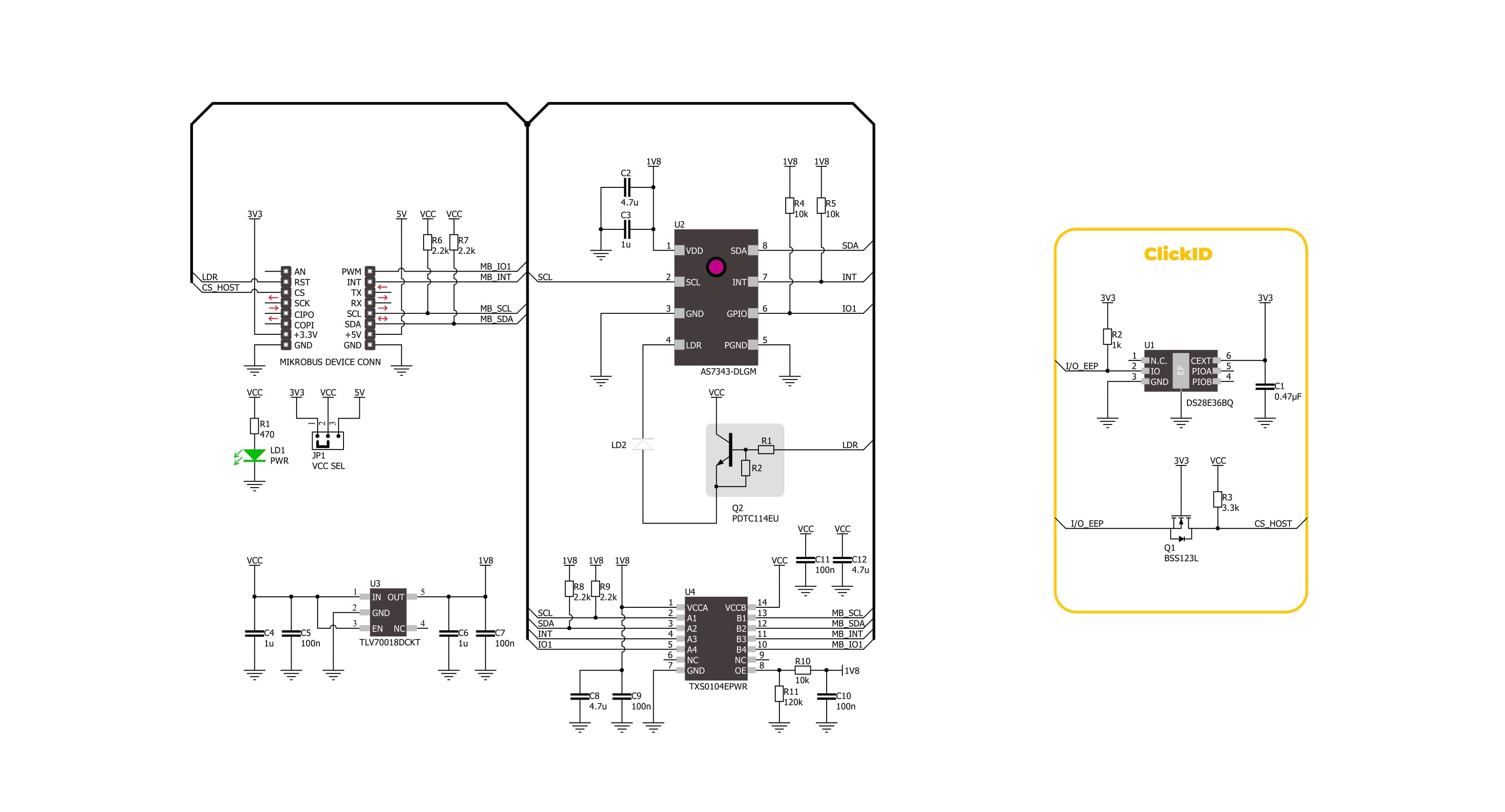
Step by step
Project assembly
Software Support
Library Description
Color 16 Click demo application is developed using the NECTO Studio, ensuring compatibility with mikroSDK's open-source libraries and tools. Designed for plug-and-play implementation and testing, the demo is fully compatible with all development, starter, and mikromedia boards featuring a mikroBUS™ socket.
Example Description
This example demonstrates the use of Color 16 Click by reading and displaying the values from all 14 channels.
Key functions:
color16_cfg_setup- Config Object Initialization function.color16_init- Initialization function.color16_default_cfg- Click Default Configuration function.color16_read_data- This function checks if the spectral measurement data is ready and then reads data from all channels along with the STATUS and ASTATUS bytes.color16_set_wait_time_ms- This function sets the wait time in milliseconds by setting the WTIME register.color16_set_integration_time_ms- This function sets the integration time in milliseconds by setting the ATIME and ASTEP registers.
Application Init
Initializes the driver and performs the Click default configuration.
Application Task
Waits for the spectral measurement complete flag and then reads data from all 14 channels in 3 cycles, and displays the results on the USB UART every 300ms approximately.
Open Source
Code example
The complete application code and a ready-to-use project are available through the NECTO Studio Package Manager for direct installation in the NECTO Studio. The application code can also be found on the MIKROE GitHub account.
/*!
* @file main.c
* @brief Color 16 Click example
*
* # Description
* This example demonstrates the use of Color 16 Click by reading and displaying
* the values from all 14 channels.
*
* The demo application is composed of two sections :
*
* ## Application Init
* Initializes the driver and performs the Click default configuration.
*
* ## Application Task
* Waits for the spectral measurement complete flag and then reads data from all 14 channels
* in 3 cycles, and displays the results on the USB UART every 300ms approximately.
*
* @author Stefan Filipovic
*
*/
#include "board.h"
#include "log.h"
#include "color16.h"
static color16_t color16;
static log_t logger;
void application_init ( void )
{
log_cfg_t log_cfg; /**< Logger config object. */
color16_cfg_t color16_cfg; /**< Click config object. */
/**
* Logger initialization.
* Default baud rate: 115200
* Default log level: LOG_LEVEL_DEBUG
* @note If USB_UART_RX and USB_UART_TX
* are defined as HAL_PIN_NC, you will
* need to define them manually for log to work.
* See @b LOG_MAP_USB_UART macro definition for detailed explanation.
*/
LOG_MAP_USB_UART( log_cfg );
log_cfg.is_interrupt = false;
log_init( &logger, &log_cfg );
log_info( &logger, " Application Init " );
// Click initialization.
color16_cfg_setup( &color16_cfg );
COLOR16_MAP_MIKROBUS( color16_cfg, MIKROBUS_1 );
if ( I2C_MASTER_ERROR == color16_init( &color16, &color16_cfg ) )
{
log_error( &logger, " Communication init." );
for ( ; ; );
}
if ( COLOR16_ERROR == color16_default_cfg ( &color16 ) )
{
log_error( &logger, " Default configuration." );
for ( ; ; );
}
log_info( &logger, " Application Task " );
}
void application_task ( void )
{
color16_data_t color_data;
if ( COLOR16_OK == color16_read_data ( &color16, &color_data ) )
{
log_printf ( &logger, " STATUS: 0x%.2X\r\n", ( uint16_t ) color_data.status );
log_printf ( &logger, " ASTATUS: 0x%.2X\r\n", ( uint16_t ) color_data.astatus );
log_printf ( &logger, " ------- Cycle 1 -------\r\n" );
log_printf ( &logger, " Channel FZ: %u\r\n", color_data.ch_fz );
log_printf ( &logger, " Channel FY: %u\r\n", color_data.ch_fy );
log_printf ( &logger, " Channel FXL: %u\r\n", color_data.ch_fxl );
log_printf ( &logger, " Channel NIR: %u\r\n", color_data.ch_nir );
log_printf ( &logger, " Channel 2xVIS_1: %u\r\n", color_data.ch_2x_vis_1 );
log_printf ( &logger, " Channel FD_1: %u\r\n", color_data.ch_fd_1 );
log_printf ( &logger, " ------- Cycle 2 -------\r\n" );
log_printf ( &logger, " Channel F2: %u\r\n", color_data.ch_f2 );
log_printf ( &logger, " Channel F3: %u\r\n", color_data.ch_f3 );
log_printf ( &logger, " Channel F4: %u\r\n", color_data.ch_f4 );
log_printf ( &logger, " Channel F6: %u\r\n", color_data.ch_f6 );
log_printf ( &logger, " Channel 2xVIS_2: %u\r\n", color_data.ch_2x_vis_2 );
log_printf ( &logger, " Channel FD_2: %u\r\n", color_data.ch_fd_2 );
log_printf ( &logger, " ------- Cycle 3 -------\r\n" );
log_printf ( &logger, " Channel F1: %u\r\n", color_data.ch_f1 );
log_printf ( &logger, " Channel F5: %u\r\n", color_data.ch_f5 );
log_printf ( &logger, " Channel F7: %u\r\n", color_data.ch_f7 );
log_printf ( &logger, " Channel F8: %u\r\n", color_data.ch_f8 );
log_printf ( &logger, " Channel 2xVIS_3: %u\r\n", color_data.ch_2x_vis_3 );
log_printf ( &logger, " Channel FD_3: %u\r\n", color_data.ch_fd_3 );
log_printf ( &logger, " -----------------------\r\n\n" );
Delay_ms ( 300 );
}
}
int main ( void )
{
/* Do not remove this line or clock might not be set correctly. */
#ifdef PREINIT_SUPPORTED
preinit();
#endif
application_init( );
for ( ; ; )
{
application_task( );
}
return 0;
}
// ------------------------------------------------------------------------ END
Additional Support
Resources
Category:Optical




















